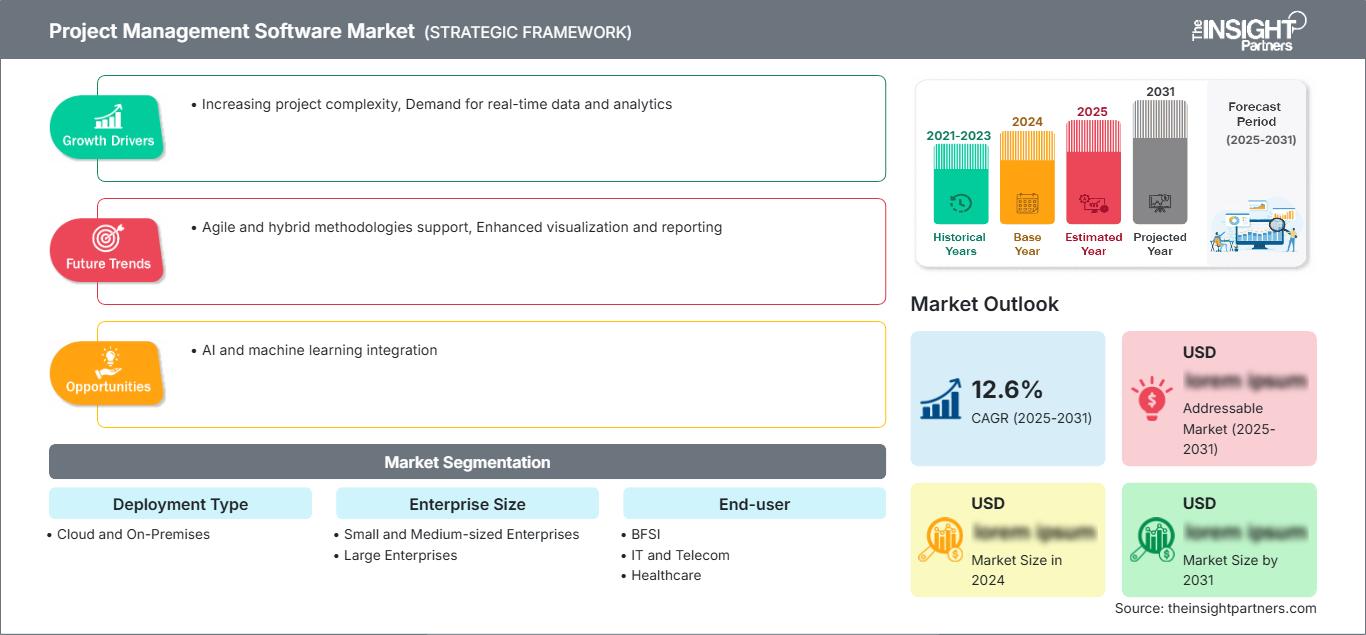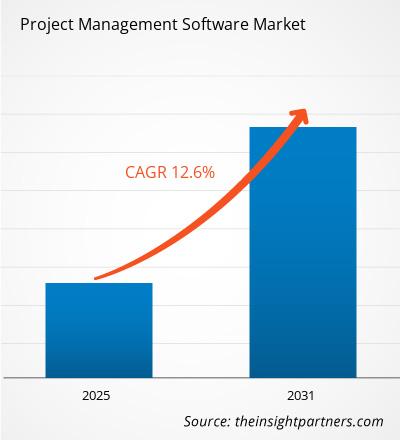Der Markt für Projektmanagement-Software wird zwischen 2023 und 2031 voraussichtlich eine durchschnittliche jährliche Wachstumsrate (CAGR) von 12,6 % verzeichnen. Die Unterstützung agiler und hybrider Methoden sowie verbesserte Visualisierung und Berichterstattung werden voraussichtlich weiterhin wichtige Markttrends bleiben.
Marktanalyse für Projektmanagement-Software
- Projektmanagement-Software wird derzeit branchenübergreifend immer häufiger eingesetzt, von Großunternehmen und Automobilherstellern bis hin zu Bauunternehmen, Agenturen und NGOs.
- Die boomende Nachfrage nach Cloud-basierten, mobilfreundlichen Lösungen ist das Ergebnis anhaltender Remote-Arbeit, zunehmender Initiativen zur digitalen Transformation und der Erkenntnis der Unternehmen, welchen Mehrwert sie ihren Mitarbeitern bieten können, um Effizienz, Zusammenarbeit und Projekterfolg zu steigern.
- Unternehmen entwickeln einen Wunsch nach integrierten Plattformen und fragen nun nach Tools, die eine Kombination aus den Kernfunktionen von Projektmanagement- und agiler Software sowie granulare Analysen, KI-gestützte Erkenntnisse und Automatisierung bieten, um eine Vielzahl unterschiedlicher Lösungen zu ersetzen.
Marktübersicht für Projektmanagement-Software
- Der Markt für Projektmanagement-Software wächst stark. Die fortschreitende Digitalisierung treibt den Bedarf an effizienteren Tools für die Zusammenarbeit voran, und immer mehr Startups konkurrieren mit etablierten Technologieanbietern.
- Der Markt reicht von einfachen Aufgabenverwaltungslösungen bis hin zu Projektmanagement auf Unternehmensebene, wobei Cloud-basierte Angebote dank größerer Skalierbarkeit und verbessertem Fernzugriff immer beliebter werden.
- Der Markt verlagert sich auf intuitivere, KI-fähige Lösungen, die sich in andere Geschäftstools und -dienste integrieren lassen, und wir erwarten, dass dieser Markt weiter expandiert, da Projektmanagement fast überall mit effektiveren Geschäftsergebnissen in Verbindung gebracht wird.
Passen Sie diesen Bericht Ihren Anforderungen an
Sie erhalten kostenlos Anpassungen an jedem Bericht, einschließlich Teilen dieses Berichts oder einer Analyse auf Länderebene, eines Excel-Datenpakets sowie tolle Angebote und Rabatte für Start-ups und Universitäten.
Markt für Projektmanagement-Software: Strategische Einblicke

- Holen Sie sich die wichtigsten Markttrends aus diesem Bericht.Dieses KOSTENLOSE Beispiel umfasst Datenanalysen, die von Markttrends bis hin zu Schätzungen und Prognosen reichen.
Markttreiber und -chancen für Projektmanagement-Software: Steigende Projektkomplexität begünstigt den Markt
Sie erhalten kostenlos Anpassungen an jedem Bericht, einschließlich Teilen dieses Berichts oder einer Analyse auf Länderebene, eines Excel-Datenpakets sowie tolle Angebote und Rabatte für Start-ups und Universitäten.
Markt für Projektmanagement-Software: Strategische Einblicke

- Holen Sie sich die wichtigsten Markttrends aus diesem Bericht.Dieses KOSTENLOSE Beispiel umfasst Datenanalysen, die von Markttrends bis hin zu Schätzungen und Prognosen reichen.
- Die zunehmende Projektkomplexität treibt das Wachstum des expandierenden Marktes für Projektmanagement-Software voran, da die Komplexität der Projekte den Planungsbedarf auf anspruchsvollere Organisationsebenen verlagert hat.
- Da der Projektumfang sich auf mehr Funktionen und zu berücksichtigende Aspekte ausweitet, die Arbeit zunehmend auf verschiedene Teams verteilt ist und die Stakeholder-Gruppen komplexer werden, ist es unmöglich geworden, mit denselben veralteten Tools den Überblick über all diese komplexen Beziehungen zu behalten.
- Bei größeren Projekten, bei denen mehr Leute über mehrere Abteilungen oder sogar verschiedene Organisationen hinweg arbeiten, kann das Management mit der Komplexität der Aufgabenabhängigkeiten, der Ressourcenzuweisung über mehrere Teams hinweg, dem Risikomanagement für kompliziertere Szenarien und der Datenintegration aus einer Reihe von Quellen nicht mehr Schritt halten.
- Gleichzeitig bedeuten mehr Leute mehr Gesamtaufgaben, mehr Hierarchien und Beziehungen zwischen diesen Aufgaben und mehr Entscheidungen, die getroffen werden müssen. Diese Komplexität erfordert strengere Berichts- und Analyseanforderungen, damit Informationen auf kohärente Weise gesammelt werden können.
- Projektmanagement-Softwarelösungen sind in diesen komplexen Situationen wichtig, um diese größeren Projekte zu bewältigen und zu steuern. Ausgefeilte Funktionen von Projektmanagement-Software wie Echtzeit-Zusammenarbeit, automatisierte Workflows und sogar prädiktive Analysen auf Basis von maschinellem Lernen können die Projektplanung und -ausführung unterstützen.
Integration von KI und maschinellem Lernen
- Die Integration von KI und maschinellem Lernen bietet lukrative Möglichkeiten auf dem Markt für Projektmanagement-Software, da diese Technologien dazu beitragen, Routineanfragen, Aufgaben und Zuweisungen zu automatisieren und prädiktive Fähigkeiten und Erkenntnisse zu erweitern.
- Diese Technologien ermöglichen es Projektmanagement-Tools, vorhandene Daten statistisch zu analysieren und potenzielle Risiken, Verzögerungen oder Ressourcenengpässe zu visualisieren, bevor sie tatsächlich auftreten. So können Projektmanager proaktiv handeln.
- Langfristig können KI-gestützte Chatbots und virtuelle Assistenten dazu beitragen, Routineanfragen, Antworten und Aufgabenzuweisungen zu automatisieren, sodass sich Projektmanager stärker auf strategische Arbeit konzentrieren können.
Segmentierungsanalyse des Marktberichts für Projektmanagement-Software
Schlüsselsegmente, die zur Ableitung der Marktanalyse für Projektmanagement-Software beigetragen haben, sind Bereitstellungstyp, Unternehmensgröße und Endbenutzer.
- Basierend auf dem Bereitstellungstyp ist der Markt für Projektmanagement-Software in Cloud und On-Premises unterteilt.
- Basierend auf der Unternehmensgröße ist der Markt für Projektmanagement-Software in kleine und mittlere Unternehmen sowie große Unternehmen unterteilt.
- Basierend auf dem Endbenutzer ist der Markt für Projektmanagement-Software in BFSI, IT und Telekommunikation, Gesundheitswesen, Einzelhandel, Fertigung, Regierung und andere unterteilt.
Analyse der Marktanteile von Projektmanagement-Software nach Geografie
- Der Marktbericht für Projektmanagement-Software umfasst eine detaillierte Analyse von fünf großen geografischen Regionen, einschließlich der aktuellen und historischen Marktgröße und Prognosen für 2021 bis 2031, die Nordamerika, Europa, Asien-Pazifik (APAC), Naher Osten und Afrika (MEA) sowie Süd- und Mittelamerika abdecken.
- Jede Region ist weiter in entsprechende Länder unterteilt. Dieser Bericht bietet Analysen und Prognosen für über 18 Länder und deckt die Marktdynamik von Projektmanagement-Software ab, wie z. B. Treiber, Trends und Chancen, die die Märkte auf regionaler Ebene beeinflussen.
- Darüber hinaus umfasst der Bericht eine PEST-Analyse, die die Untersuchung der wichtigsten Faktoren umfasst, die den Markt für Projektmanagement-Software in diesen Regionen beeinflussen.
Markt für Projektmanagement-Software
Die Analysten von The Insight Partners haben die regionalen Trends und Faktoren, die den Markt für Projektmanagement-Software im Prognosezeitraum beeinflussen, ausführlich erläutert. In diesem Abschnitt werden auch die Marktsegmente und die geografische Lage in Nordamerika, Europa, dem asiatisch-pazifischen Raum, dem Nahen Osten und Afrika sowie Süd- und Mittelamerika erörtert.Umfang des Marktberichts zur Projektmanagement-Software
| Berichtsattribut | Einzelheiten |
|---|---|
| Marktgröße in 2024 | US$ XX million |
| Marktgröße nach 2031 | US$ XX Million |
| Globale CAGR (2025 - 2031) | 12.6% |
| Historische Daten | 2021-2023 |
| Prognosezeitraum | 2025-2031 |
| Abgedeckte Segmente |
By Bereitstellungstyp
|
| Abgedeckte Regionen und Länder | Nordamerika
|
| Marktführer und wichtige Unternehmensprofile |
|
Dichte der Marktteilnehmer für Projektmanagement-Software: Verständnis ihrer Auswirkungen auf die Geschäftsdynamik
Der Markt für Projektmanagement-Software wächst rasant. Dies wird durch die steigende Nachfrage der Endnutzer aufgrund veränderter Verbraucherpräferenzen, technologischer Fortschritte und eines stärkeren Bewusstseins für die Produktvorteile vorangetrieben. Mit der steigenden Nachfrage erweitern Unternehmen ihr Angebot, entwickeln Innovationen, um den Bedürfnissen der Verbraucher gerecht zu werden, und nutzen neue Trends, was das Marktwachstum weiter ankurbelt.

- Holen Sie sich die Markt für Projektmanagement-Software Übersicht der wichtigsten Akteure
Der Markt für Projektmanagement-Software wird durch die Erhebung qualitativer und quantitativer Daten aus Primär- und Sekundärforschung bewertet, die wichtige Unternehmenspublikationen, Verbandsdaten und Datenbanken umfasst. Einige der Entwicklungen auf dem Markt für Projektmanagement-Software sind nachfolgend aufgeführt:
- Asana, Inc. (NYSE: ASAN) (LTSE: ASAN), ein führender Anbieter von Enterprise-Work-Management-Lösungen, kündigte neue Funktionen auf Basis künstlicher Intelligenz (KI) an, die Führungskräften, Abteilungen und ganzen Organisationen mehr Klarheit, Wirkung und Skalierbarkeit bieten. Mithilfe von Asanas Work Graph ermöglichen diese neuen KI-Funktionen auf Unternehmensniveau Führungskräften, ihre Organisationen schneller auf das Erreichen von Zielen und das Erzielen von Ergebnissen auszurichten. (Quelle: Asana, Inc., Pressemitteilung, Oktober 2023)
Bericht zum Markt für Projektmanagement-Software: Umfang und Ergebnisse
Der „Markt für Projektmanagement-Software – Größe und Prognose (2021–2031)“ Der Bericht bietet eine detaillierte Analyse des Marktes und deckt die folgenden Bereiche ab:
- Marktgröße und Prognose für Projektmanagement-Software auf globaler, regionaler und Länderebene für alle abgedeckten wichtigen Marktsegmente
- Markttrends und Marktdynamiken für Projektmanagement-Software wie Treiber, Einschränkungen und wichtige Chancen
- Detaillierte PEST/Porters Five Forces- und SWOT-Analyse
- Marktanalyse für Projektmanagement-Software mit wichtigen Markttrends, globalen und regionalen Rahmenbedingungen, wichtigen Akteuren, Vorschriften und aktuellen Marktentwicklungen
- Branchenlandschaft und Wettbewerbsanalyse mit Marktkonzentration, Heatmap-Analyse, prominenten Akteuren und aktuellen Entwicklungen für den Markt für Projektmanagement-Software
- Detaillierte Unternehmensprofile
- Historische Analyse (2 Jahre), Basisjahr, Prognose (7 Jahre) mit CAGR
- PEST- und SWOT-Analyse
- Marktgröße Wert/Volumen – Global, Regional, Land
- Branchen- und Wettbewerbslandschaft
- Excel-Datensatz
Aktuelle Berichte
Verwandte Berichte
Erfahrungsberichte
Grund zum Kauf
- Fundierte Entscheidungsfindung
- Marktdynamik verstehen
- Wettbewerbsanalyse
- Kundeneinblicke
- Marktprognosen
- Risikominimierung
- Strategische Planung
- Investitionsbegründung
- Identifizierung neuer Märkte
- Verbesserung von Marketingstrategien
- Steigerung der Betriebseffizienz
- Anpassung an regulatorische Trends




















 Kostenlose Probe anfordern für - Markt für Projektmanagement-Software
Kostenlose Probe anfordern für - Markt für Projektmanagement-Software